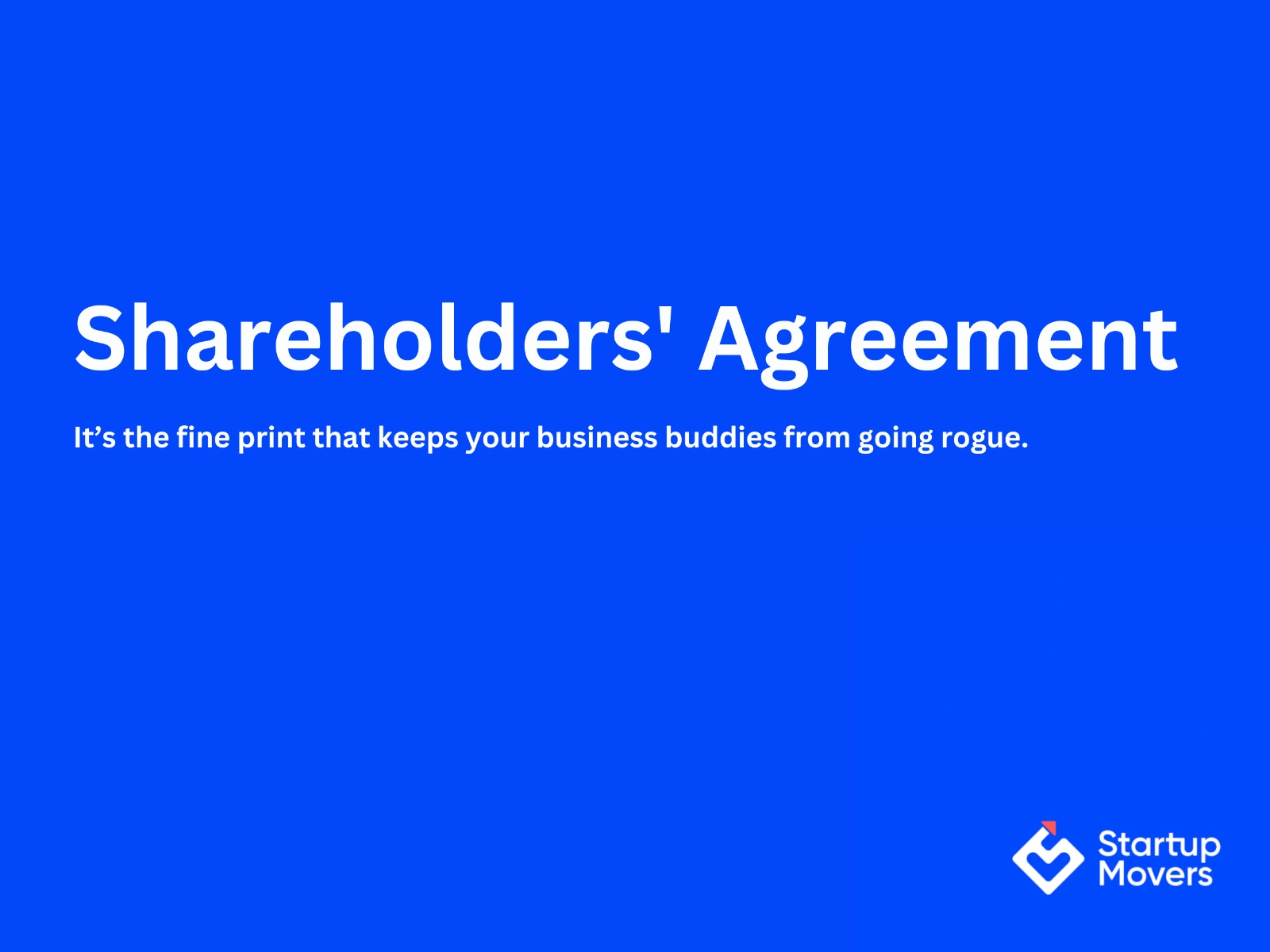Understanding Softex Filings




Think your shares are secure? Think again. Without a Shareholders' Agreement, co-founder disputes, investor exits, and profit-sharing conflicts can spiral into legal chaos and financial loss. Who makes the big decisions? What happens if someone wants out? Without clear rules, businesses can crumble under power struggles and lawsuits.
Read more to discover why every shareholder needs this critical contract.
A Shareholders' Agreement is a legally binding contract that acts as the ground rules for company ownership. Think of it as the blueprint of shareholder relations, ensuring smooth operations and preventing conflicts.
It answers crucial questions like:
Without a clear, legally sound Shareholders' Agreement, companies risk miscommunication, unfair treatment, and legal entanglements.
💡 Pro Tip: Even the best partnerships can turn sour. A written agreement ensures everyone is on the same page.
The parties to a shareholders' agreement are like the key players in a game, each with their own role and responsibility. Here's how it works:
If your company has more than one shareholder, a Shareholders' Agreement is non-negotiable.
🚀 Startups move fast—co-founders may leave, investors may demand control, and equity splits can turn into battles. A Shareholders' Agreement protects the vision and stability of the company.
💰 Investors want security. This agreement ensures their rights, decision-making powers, and exit strategies are well-defined.
👨👩👧 Mixing family and business? Things can get messy. A Shareholders' Agreement prevents conflicts over control, profit distribution, and succession planning.
📈 As businesses expand, new shareholders bring fresh challenges. An agreement defines governance, voting rights, and share transfer restrictions.
💡 Pro Tip: No matter the size of your company, a Shareholders' Agreement is the foundation of a conflict-free business.
Lay the legal foundation today with clear shareholder terms
Create my AgreementA well-crafted Shareholders' Agreement is the secret recipe for a smooth-running company. It’s the ultimate guidebook that sets clear expectations for everyone involved, preventing unnecessary conflicts and misunderstandings. Here are the must-have clauses that should be included to keep things running smoothly:
Each of these clauses plays a crucial role in making sure that everyone’s on the same page and that the business is protected against potential conflicts. A well-drafted Shareholders' Agreement isn’t just a piece of paper; it’s your company’s best defense against chaos and confusion.
A well-crafted Shareholders' Agreement is the secret recipe for a smooth-running company. It’s the ultimate guidebook that sets clear expectations for everyone involved, preventing unnecessary conflicts and misunderstandings. Here are the must-have clauses that should be included to keep things running smoothly:
How it works: If the majority shareholder decides to sell their shares to a third party, the minority shareholders can "tag along" and sell their shares on the same terms. This ensures they don’t miss out on a profitable exit or get stuck with a new owner they don’t want.
How it works: If the majority shareholder has found a buyer and decides to sell, minority shareholders are required to sell their shares on the same terms. This protects the majority from the frustration of having one or two shareholders holding out and preventing the sale, thereby facilitating smoother exits for the company.
It keeps the company funded without unexpected financial burdens!
Protects shareholders from unexpected financial risks!
It ensures that shareholders have a say in the big moves!
It’s a win-win—employees stay, and the company thrives!
Because business must move forward!.
Ensures a clean, conflict-free closure.
These provisions keep the agreement flexible, enforceable, and prepared for unforeseen challenges
A well-drafted Shareholders' Agreement isn’t just paperwork—it’s the blueprint for a smooth, dispute-free business. Make sure yours covers all the right clauses before sealing the deal!
Without a Shareholders' Agreement, a company can quickly descend into confusion, disputes, and financial risks. Here’s why having one is non-negotiable:
🚨 No Agreement = High Risk 🚨
Think of it like driving without a seatbelt—things may be fine for now, but when trouble strikes, you’re completely exposed. Secure your business today!
A good Shareholders' Agreement ensures that minority shareholders aren’t sidelined. Here’s how it helps protect their rights:
Shareholder disputes are more common than you might think, and many businesses—large or small—have faced the consequences of not having a clear Shareholders' Agreement.
Let’s explore some real-life examples where the lack of proper agreements led to costly battles and significant disruptions.:
📌 Facebook’s Eduardo Saverin vs. Mark Zuckerberg (2004)
In one of the most famous legal battles in Silicon Valley, Eduardo Saverin, co-founder of Facebook, sued Mark Zuckerberg after he was diluted out of the company.
Saverin had been Facebook's original business partner but was later forced out under unclear terms regarding ownership and contributions.
The case revolved around Saverin’s shareholding rights, which were never clearly outlined in the early stages of Facebook’s growth.
This legal dispute was eventually settled out of court, but it became widely known after it was depicted in the movie The Social Network (2010).
Lesson: A Shareholders' Agreement should clearly outline how shares are issued, diluted, and distributed, especially in the startup phase.
📌 Tata Sons vs. Cyrus Mistry (2016-2017)
In the high-profile dispute within the Tata Group, Cyrus Mistry (the former chairman) clashed with the Tata family over his removal from the board.
The dispute was largely about the lack of clarity on board powers and minority shareholder protection, leading to a series of lawsuits and public infighting.
Mistry claimed that he was unfairly removed and that his minority rights were disregarded.
A clear Shareholders' Agreement could have outlined how board decisions were to be made and provided protection for minority shareholders.
Lesson: Protect minority shareholders and outline the decision-making process thoroughly.
📌 Tesla: Elon Musk vs. Shareholders (2018)
In 2018, Elon Musk, CEO of Tesla, was embroiled in a legal conflict with Tesla’s shareholders over his social media posts and executive compensation.
Musk’s controversial tweet about taking Tesla private led to a lawsuit from shareholders accusing him of misleading them and causing Tesla’s stock price to fluctuate wildly. This was just one of the many instances where the lack of clear agreements about executive powers and compensation structures led to conflicts.
Lesson: Clear communication between shareholders and executives, along with restrictions on CEO actions, could help mitigate such conflicts.
Each of these disputes—Facebook, Tata Sons, and Tesla—could have been avoided or at least mitigated with a solid, comprehensive Shareholders' Agreement in place. These agreements define everything from ownership rights, exit strategies, to dispute resolution processes, ensuring that conflicts are handled before they escalate.
✅ Step 1: Define Roles and Ownership
Clarify who the shareholders are and their respective ownership percentages. This should include:
✅ Step 2: Draft Key Clauses
The essential clauses to focus on:
✅ Step 3: Consult a Legal Expert
Work with a legal expert to ensure the agreement is structured correctly and complies with the relevant laws. They will help iron out any ambiguous clauses and make sure the agreement is airtight.
✅ Step 4: Review and Sign
Before finalizing, ensure all shareholders review the agreement thoroughly and sign it. Having everyone on the same page prevents confusion and potential conflicts later.
💡Pro Tip: Always put everything in writing—verbal agreements are risky and often lead to misunderstandings.
Conclusion: Keep Things Fair, Keep Things Clear
A Shareholders' Agreement isn’t just paperwork—it’s business insurance. It safeguards investments, clarifies governance, and ensures long-term stability. Whether you're a startup or an established firm, having a well-drafted Shareholders' Agreement is non-negotiable.
Don't wait for conflicts to arise—secure your business relationships today! After all, the future of your company depends on the decisions made today.
Define roles, responsibilities, and exit strategies to avoid costly disputes and misunderstandings
Get Started Now!Q. How to read a Shareholders' Agreement?
Reading a Shareholders' Agreement requires understanding key clauses such as ownership structure, decision-making powers, and dispute resolution. Focus on provisions like voting rights, exit strategies, and dividend distribution to assess how decisions are made and how profits are shared. Understanding the language is crucial to ensure fairness and transparency.
Q. How does a Shareholders' Agreement work?
A Shareholders' Agreement outlines the relationship between company owners and establishes clear guidelines for governance, decision-making, and resolving conflicts. It works by setting rules for things like voting rights, dividend distribution, and shareholder exits, ensuring smooth operations and protecting all parties involved.
Q. What Are the Main Terms of a Shareholders' Agreement?
The main terms of a Shareholders' Agreement typically include ownership structure, voting rights, decision-making processes, dividend distribution, exit strategies, and dispute resolution. These terms ensure the company operates smoothly and minimizes conflicts among shareholders.
Q. What Is the purpose of a Shareholders Agreement?
The purpose of a Shareholders' Agreement is to provide clarity on ownership rights, governance, and the responsibilities of each shareholder. It serves as a safeguard against disputes and offers solutions for situations like shareholder exits or disagreements, ensuring the business runs efficiently and fairly.
Q.Can a Shareholders' Agreement be modified?
Yes, a Shareholders' Agreement can be modified, but changes require the consent of all shareholders or a specified majority, depending on the terms set in the agreement. Modifications ensure the document remains relevant as the business evolves.
Q. What happens if a shareholder wants to leave the company?
When a shareholder decides to leave, the agreement typically provides guidance on how to handle the process. It often includes provisions like a right of first refusal, buyout options, or restrictions on selling shares to third parties, which ensures the exit is managed smoothly and according to pre-agreed terms.
Q. What is the difference between a term sheet and a Shareholders' Agreement?
A term sheet is a preliminary agreement that outlines the key terms of an investment, whereas a Shareholders' Agreement is a formal, legally binding contract that details the rights and obligations of shareholders. The term sheet acts as a roadmap, while the Shareholders' Agreement is the final destination.
Create a Shareholders' Agreement that protects your vision and ensures smooth operations. We’ll walk you through the process
Secure My Terms Today!
